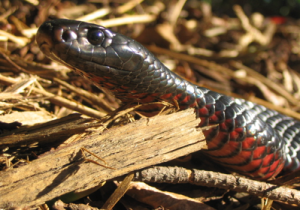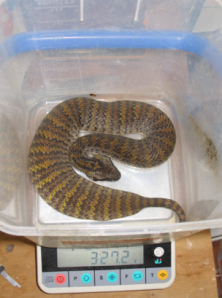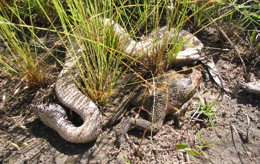Snakes and Toads
You may or may not have gathered by now, but I care about snakes. In fact, it could be argued that I misspent my youth chasing them. In these adolescent ophidiophilic quests, it soon became apparent that a) snakes are much harder to find than popular mythology suggests, and b) if you want to find a red-bellied black snake, you had best look somewhere where there are no cane toads.
Red-bellied blacks are the quintessential Australian snake: stout, happy-go-lucky adventurers with a healthy passion for food and romance. And they are good looking to boot. Cane toads, on the other hand are somewhat less attractive creatures, and they are new to our shores. New in an evolutionary sense, anyway (they were introduced in 1935), which means that Australian natives (including the snakes) are simply not adapted to deal with the great big sack of cardio-active toxins that the toad shoulders with it everywhere. So, big dumb Australian snake sees a toad, mistakes it for a frog, attempts to eat it, and dies in the process. This is an unhappy story.
But it’s not the end of the story either. It’s the end for that particular snake and toad, of course, but what about the snakes that aren’t so dumb? What about the snakes that notice that toads might be something nasty? What about the snakes that are, through sheer dumb luck, relatively immune to toad toxin? I wondered a lot about these snakes. Wondered so hard, in fact, that they ended up giving me a PhD for all my wondering.
These snakes - the survivors, the toad smart individuals - there are not many of them, but in some places they have managed to band together in large enough numbers to form a functional population. These post-toad populations are made up almost entirely of toad-smart individuals, and the smarts, it seems, are heritable. Evolution has happened since the arrival of toads, and in some cases it has happened fast.
Mostly, toad smart individuals simply won’t attempt to eat a toad. This is the simplest and most effective way to reduce the impact of toads on your life to something approaching utterly negligible. There are also subtle shifts in other traits: for example, relative head size (if you eat smaller toads because your head is smaller, you are less likely to end up dead), and toxin resistance (higher resistance equals higher safety). But these shifts are typically small, and probably happened during the process of evolving a strong distaste for toads. It is this strong distaste for toads that is the critical trait allowing some populations, at least, to prosper despite the presence of toads.
So it turns out to be not entirely true that you need a toad free spot if you want to find a red bellied black. There are, in fact, several very good places for finding blackies inside the 1.3 million square kilometres of Australia that is occupied by toads. And happily enough, the list of places seems to grow steadily. This makes the adolescent in me happy.



